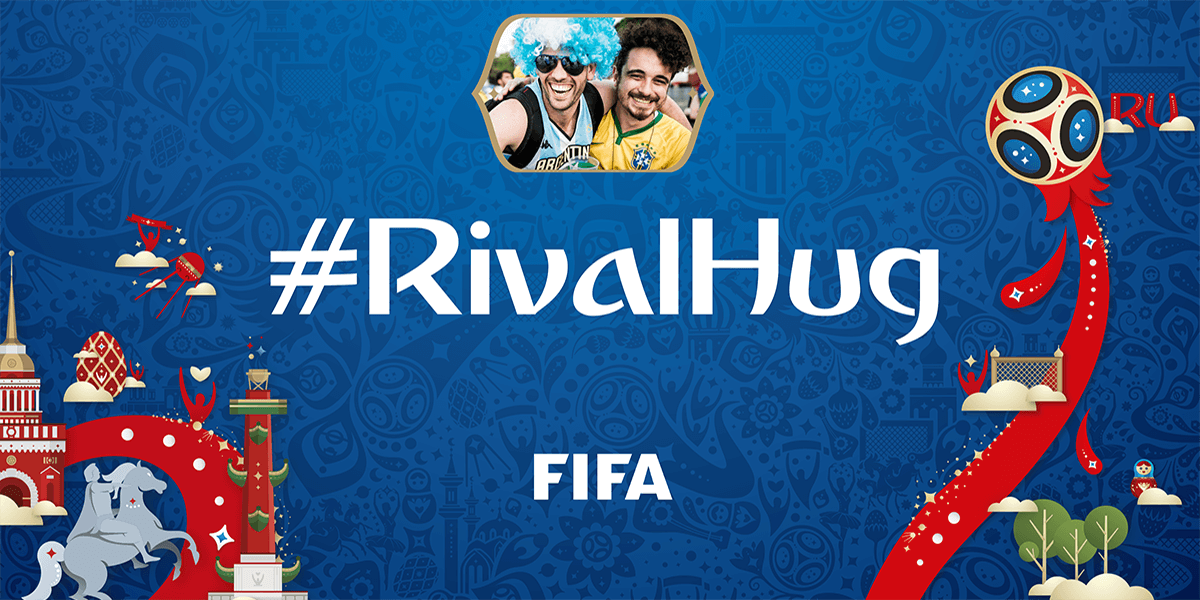Winner Spotlight: FIFA #RivalHug
Winner Spotlight: FIFA #RivalHug – Engage by Hashtag Sports

By
![]() Team Hashtag
•
3 min read
Team Hashtag
•
3 min read
January 21, 2020
The following interview with Jung von Matt/SPORTS’ Managing Director, Holger Hansen, is part of our Campaign Spotlight series, which examines last year’s Hashtag Sports Award-winning work. FIFA #RivalHug won for Best Event-Based Activation, which recognizes an innovative brand activation, stunt, or in-person experience built to engage fans on-site at a live sporting event.
What unique objective or goals led to the creation of this work?
In 2018, Russia hosted the FIFA World Cup, the largest sporting event in the world. In total, more than 3.5 billion people worldwide watched the matches in the stadiums, on public viewings, and on TV screens at home. During the tournament, more than 7 million local and international fans visited the official public viewing area from FIFA in the heart of Moscow: FIFA Fan Fest.
As the owner of the Cup, FIFA’s trump card within all the communicative buzz is its access to once-in-a-lifetime experiences – such as exclusive tickets for the final. The world federation aimed to bring fans together and prove the unifying power of football – emotionalizing the brand and making it tangible by leveraging access and creating a unique experience for visitors that showcased to the world that FIFA is more than just the organizing entity.
How was the entry designed and implemented with the modern sports fan in mind?
We made use of a global football ritual that is lived on and off the pitch – the #RivalHug. Football is characterized by rivalries that turn teams and fans into opponents. At the same time, however, it’s framed by mutual respect, which unites them. This is a phenomenon that translates perfectly into a strong communicative mechanism: Through the hashtag #RivalHug, fans share their moments of fraternization – and cause massive UGC.
We kicked off with an emotional film on the FIFA Fan Fest screens and social media and made people aware of the activation which included a custom made photo booth with an integrated “Hug Counter“ that attracted thousands of fans to take a photo with their rivals, share it online and become part of the movement. We then opened the activation to fans worldwide and called on them to share their #RivalHug on social media. Afterward, we played reactive #RivalHug highlights across social channels and created recurring content formats like the #HugOfTheDay. Additionally, influencers promoted the campaign and even the mascot Zabivaka became “Hugivaka.“ The best #RivalHug submissions were rewarded with tickets.
How did this work achieve effective engagement and what measurable outcomes were delivered?
#RivalHug was FIFA’s biggest fan activation ever. The campaign was distributed in 9 different languages across over 20 local and global FIFA channels. After the World Cup, it had generated 221.9 million impressions, 170 million net contacts, 55 million video views, 9 million interactions, 26,240 #RivalHug tags and 9,357 submissions on social media. #RivalHug became the talk-of-the-town, but also the global classic media jumps on the bandwagon and creates huge PR amplification with a total value of 6.6 billion through over 70 articles in 29 nations.
What new benchmark(s) in fan engagement does this set? How will this work inspire and move the industry forward?
RivalHug is the biggest campaign in the history of FIFA. Never before has a communicative measure of the association touched so many people emotionally and encouraged them to participate. The campaign was also well received with FIFA sponsors as two of the biggest (Coca-Cola and Budweiser) picked up on the content and become a part of the campaign themselves, integrating FIFA’s hashtag #RivalHug into their World Cup communications.
What do you think made the #RivalHug campaign so appealing to your target audience?
The whole #RivalHug case was based on a well-known gesture; showing respect to your opponent. You can be rivals on the pitch, but after 90 minutes you hug your rival, therefore, showing respect to each other. Bringing this learned gesture, from the pitch to the stands and connecting different types of people, nationalities, religions, and genders was one of the major points why the campaign was so appealing.
Another point was that the entry barrier to participate was very low. The fans just needed to upload their photo or moving image content, using the #RivalHug and they were in the lottery.
Can you share a bit on any research on fans your team conducted prior to developing this campaign?
Together with FIFA, we developed a framework that allowed us to segment the global football fan into different fan groups. All of those groups differed from each other with regards to their football involvement, their need for social interaction and other factors. For each specific group, we dug deeper to find out as much as possible about their lifestyle and behavior – and we were also on the ground in Russia to talk to fans. Eventually, the development and exploration of the different fan groups allowed us to create highly tailored content as well as content that works for all.
FIFA was one of only 25 inaugural Hashtag Sports Award winners. What does this honor in engagement excellence mean to FIFA and the Rival Hug campaign?
It´s a great honour to be one of the first and only 25 Hashtag Sports Award winners. With the help of the award, the campaign attracted further attention outside the original target group. Marketing experts within the industry applauded the campaign, further broadening the reach of the #RivalHug campaign.

We’re now accepting entries for the 2020 Hashtag Sports Awards presented by Budweiser. Ensure your company’s work is recognized for excellence in engagement alongside our inaugural class of winners. Click here to view the categories or click here to get started.